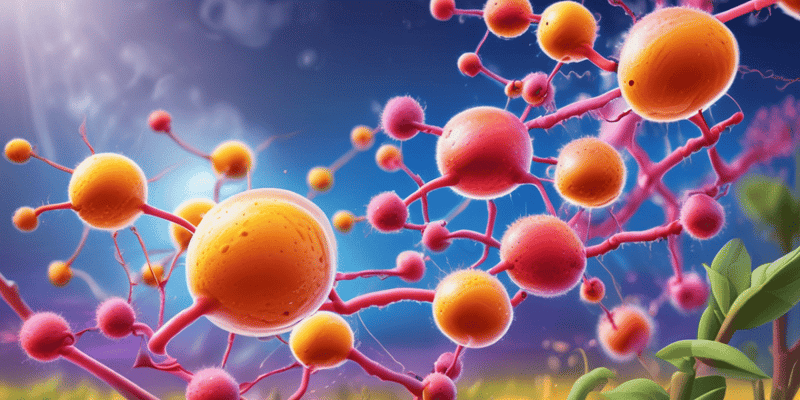Questions and Answers
What is the main purpose of fermentation in cellular respiration?
To recycle NADH back to NAD+ for glycolysis to continue
Which of the following molecules can be used as an alternate substrate for cellular respiration when glucose is not available?
Both amino acids and triglycerides
What is the purpose of the deamination process when using amino acids as an alternate substrate for cellular respiration?
To remove the nitrogen from the amino acids
When triglycerides are used as an alternate substrate for cellular respiration, what are the two main products that can be used for energy production?
Signup and view all the answers
Which of the following is NOT a step in the process of using amino acids or triglycerides as alternate substrates for cellular respiration?
Signup and view all the answers
What is the main role of the electron transport chain (ETC) in the process of oxidative phosphorylation?
Signup and view all the answers
If the electron transport chain is blocked at complex III, what would be the expected effect on ATP production?
Signup and view all the answers
What is the purpose of the investment phase of glycolysis?
Signup and view all the answers
Which of the following components is NOT required for the process of oxidative phosphorylation in the mitochondria?
Signup and view all the answers
What is the primary role of the electron transport chain (ETC) in cellular respiration?
Signup and view all the answers
Which of the following accurately describes the role of oxygen in cellular respiration?
Signup and view all the answers
If the electron transport chain is inhibited, which process(es) can still occur to produce ATP?
Signup and view all the answers
In which process does substrate-level phosphorylation occur during cellular respiration?
Signup and view all the answers
What is the primary function of the citric acid cycle in cellular respiration?
Signup and view all the answers
Which of the following is the correct sequence of events in cellular respiration?
Signup and view all the answers
What is the primary role of NADH and FADH2 in cellular respiration?
Signup and view all the answers
What is the term used to describe the process of ATP synthesis driven by the proton motive force across the inner mitochondrial membrane?
Signup and view all the answers
Study Notes
Fermentation and Cellular Respiration
- Fermentation recycles NADH back to NAD+ to maintain glycolysis.
- Fermentation is involved in the catabolism of glucose to produce ATP.
Alternate Substrates for Cellular Respiration
- Amino acids can be converted into glucose, acetyl-CoA, or citric acid cycle intermediates after deamination.
- Triglycerides can be split into glycogen and fatty acids, which can be converted into acetyl-CoA, NADH, and FADH2 through beta-oxidation.
Cellular Respiration Overview
- Cellular respiration is the process of breaking down glucose to produce ATP using substrate-level and oxidative phosphorylation.
- The three stages of cellular respiration are glycolysis, pyruvate oxidation, and the citric acid cycle, followed by oxidative phosphorylation.
Glycolysis
- Glycolysis is the first stage of cellular respiration, using glucose as its preferred substrate.
- Glycolysis produces 2 ATP (net, via substrate-level phosphorylation), 2 NADH, and 2 pyruvate.
- Contrast the investment and payoff phases in glycolysis.
Pyruvate Oxidation and Citric Acid Cycle
- The two pyruvates from glycolysis are imported into the mitochondria via pyruvate oxidation, producing 2 acetyl-CoA, 2 NADH, and 2 CO2.
- The 2 acetyl-CoA enter the citric acid cycle, producing 2 ATP (via substrate-level phosphorylation), 6 NADH, and 2 FADH2.
Oxidative Phosphorylation
- In the mitochondrial matrix, NADH and FADH2 from glycolysis, pyruvate oxidation, and the citric acid cycle donate high-energy electrons to the mitochondrial electron transport chain (ETC).
- The ETC uses the energy to pump H+ into the intermembrane space, generating proton motive force (PMF) across the inner membrane.
- The flow of hydrogen ions back across the inner membrane powers the production of ATP by the enzyme complex ATP synthase through chemiosmosis.
- Oxidative phosphorylation is the process of generating ATP through the ETC coupled to chemiosmosis in the mitochondria.
Electron Transport Chain and ATP Synthesis
- The electron transport chain is the process of transferring electrons from high-energy donors to oxygen, generating PMF.
- The components required for oxidative phosphorylation in the three compartments around the mitochondrial inner membrane are:
- Inner membrane: electron transport chain and ATP synthase
- Intermembrane space: hydrogen ions
- Mitochondrial matrix: NADH, FADH2, and ATP synthase
- The role of each component in the process is:
- Electron transport chain: generates PMF
- ATP synthase: produces ATP through chemiosmosis
- Hydrogen ions: drive ATP synthesis through chemiosmosis
Studying That Suits You
Use AI to generate personalized quizzes and flashcards to suit your learning preferences.
Description
Test your knowledge on the process of cellular respiration, including glycolysis, pyruvate oxidation, and ATP production through substrate level and oxidative phosphorylation.




